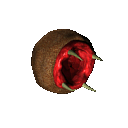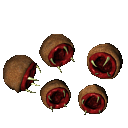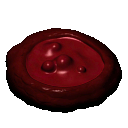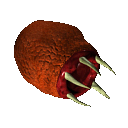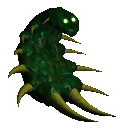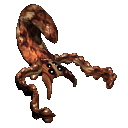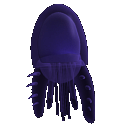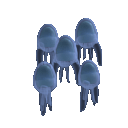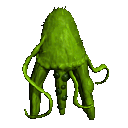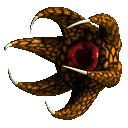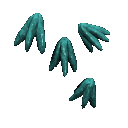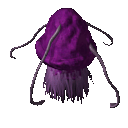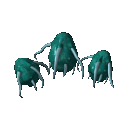www.pardus.at
| Overview | Index |
| Humanoids | Drones | Non-Sentient Life | Sentient Life |
| Biodegraders | Flora | Parasites | Serpents |
| Space Dragons | Swarms | Additional Sentient Life |
Parasites |
| Gorefangling | |||||
Disposition: Docile  Rarity: Common Region: Universal |
Immature offspring of the more formidable adult Gorefang, the lone Gorefangling presents little threat to anyone or anything. Having dispersed from its parents, a solitary Gorefangling is able to survive primarily off of the rich nebula gasses in which it is found, supplemented by occasionally scavenged detritus. Its outer shell not yet fully hardened, the vulnerable young Gorefangling only attempts to feed off living organisms when driven by starvation. If confronted, a lone Gorefangling typically attempts to hide and only attacks if pursued and provoked. This hyper-evolutionary creature will be forever remembered as one of the early harbingers of The Aperture, spreading rapidly through the universe. |
||||
| Swarm of Gorefanglings | |||||
Disposition: Predatory  Rarity: Common Region: Universal |
Having dispersed from their parents, many young Gorefanglings travel together in large swarms. Their sheer numbers quickly deplete the vital nutrients found in the nebula clouds in which they live; hence the swarms are usually voraciously hungry and readily attack nearby organisms. Though individually weak, a hungry and persistent swarm of the creatures can overpower a surprisingly large opponent. Occasionally a swarm becomes so thick that a pilot is simply unable to navigate through them, likely suffering a terrible fate as countless Gorefanglings attempt to latch onto and feed from the immobilized spacecraft. This hyper-evolutionary creature will be forever remembered as one of the early harbingers of The Aperture, spreading rapidly through the universe. |
||||
| Blood Amoeba | |||||
Disposition: Predatory  Rarity: Uncommon Region: Universal |
Though highly evolved from the single celled parasite that gave them their names, the Blood Amoeba nonetheless shares many of the same traits as its primitive cousins. Propelled by pseudopods the Blood Amoeba exists naturally in a translucent state, almost invisible to the naked eye amidst the vacuum of space. These vampiric parasites however permanently take on the crimson color they are notorious for upon their first contact with another creature's lifeblood, the Amoeba's sole source of sustenance. | ||||
| Gorefang | |||||
Disposition: Predatory  Rarity: Uncommon Region: South West and North East Universe borders |
Aptly named for the huge tusk-like fangs jutting from its mouth, the Gorefang lurks in thick clouds of nebula, absorbing the gas into its bloodstream through the thin membranes in its mouth. Though fearsome looking, the barbed fangs are actually quite fragile and are used to attach the Gorefang to a victim rather than for the mastication of food. Once attached the parasite is nearly impossible to dislodge, as its smooth outer shell is exceedingly difficult to get a grip on. Often unable to distinguish between organic and inorganic objects, the Gorefang frequently attempts to attach itself to anything that moves, including drones and piloted vessels. Though far from the most dangerous organism in the universe, an unexpected attack from a Gorefang can certainly have deadly results. This hyper-evolutionary creature will be forever remembered as one of the early harbingers of The Aperture, spreading rapidly through the universe. |
||||
| Nebula Mole | |||||
Disposition: Predatory  Rarity: Uncommon Region: Pardus and Neutral Clusters |
The Nebula Mole, as indicated by its name, can mainly be found in nebula clouds. While their sight is underdeveloped they still pose a notable threat to the average space traveler. Caution is recommended when traveling through areas with a high concentration of these creatures. The Nebula Mole is able to blend in with the nebula cloud, where it waits for unwary prey to approach. Once the would-be prey is engaged it will use its body parts to attack its victim and will actively give chase should the prey slip away. | ||||
| Dreadscorp | |||||
Disposition: Predatory  Rarity: Rare Region: Pardus and Neutral Clusters |
The Dreadscorp is a fearsome opponent; most notably so for the fact that the huge metasoma extending from its body is tipped with a venom laden telson. This makes its offensive capability incredibly high and gives it a reputation for ripping through even the toughest amours. The fact that the Dreadscorp bears some resemblance in genetic construction to that of the Earth arthropods known as scorpions led to its similar name. Many have underestimated the creature's formability due to its relatively weak outer carapace- only to regret it afterwards. | ||||
| Medusa | |||||
Disposition: Predatory  Rarity: Rare Region: Universal, not in Pardus Cluster |
The first species of the Skyphos Genus to be discovered by space travelers due to their abundance in the sectors outside of the Pardus Cluster, the Medusa was aptly named, not only for the snake-like flagella that extend from their bodies, but for the preserved state in which they leave their host victim after they have completed their union. Bonding most often with creatures that are able to exist within the vacuum of space, Human, Rashkir, Ska'ari, and Keldon have nonetheless fallen prey to these parasites as well, their perfectly preserved corpses like stone statues floating throughout the universe, the truest testament to the Medusa's infamy amidst the cosmos. | ||||
| Medusa Swarmlings | |||||
Disposition: Predatory  Rarity: Uncommon Region: Universal, not in Pardus Cluster |
Progeny of the dreaded Medusa Species, Swarmlings pose nearly as great a threat as their matured parents. Though smaller, the poison found within the barbs of their flagella is just as potent, paralyzing their host victim within seconds and leaving them helpless. | ||||
| Mutated Medusa | |||||
Disposition: Predatory  Rarity: Rare Region: Pardus Core |
Mutated by the energies of the Lucisti Virus that have come to infect the Pardus Core, these already fearsome monstrosities have evolved into a wholly new state of being. Though it matters little, the Medusa's poison, already potent enough to paralyze even some of the largest space beasts, in its mutated form has been found to be even more concentrated. The more pressing threat however is their increased resilience to modern weaponry, their gelatinous masses able to reflect many attacks based upon particle beam energy. | ||||
| Starclaw | |||||
Disposition: Aggressive  - Predatory - Predatory  Rarity: Rare Region: Split Cluster |
One of the largest life forms currently known, the Starclaw possesses great physical strength- in fact these dreadnoughts are capable of literally breaking ships in two. Primarily feeding on the minerals found in the nebula fields and possessing the ability to cloak, Starclaws are highly territorial and aggressive towards any intrusion to their habitat. | ||||
| Stheno | |||||
Disposition: Predatory  Rarity: Rare Region: Pardus Cluster, Neutral Zone, not Split Cluster |
First sister to the Medusa, the Stheno shares one distinct difference with its sibling. Rather than drawing its sustenance from the nutrient rich flesh of living matter, the Stheno feeds upon the ionic nutrients most commonly found in metal ores. Its toxin, though extremely harmful to the living, just like the Medusa's, has a property which allows it to paralyze metallic ions, much like a freezing effect metals go through when introduced to extreme, sub-zero temperatures. While a single Stheno poses a threat to any tiny spacecraft, swarms of these parasites have been known to latch onto outposts, buildings, and even entire starbases, neutralizing their offensive capabilities in a matter of moments, and leaving them defenseless for the feast. | ||||
| Stheno Swarmlings | |||||
Disposition: Predatory  Rarity: Uncommon Region: Pardus Cluster, Neutral Zone, not Split Cluster |
Offspring of the Stheno Species, or rather replications of the Stheno's genetic makeup, Swarmlings continue the misunderstood life-cycle of these ectoparasites. Their entire classification detested simply because of their natural way of life, Stheno Swarmlings innocently feast upon their host's lifeforce, entire legions sometimes found munching on the nutrient rich ores of asteroid fields. | ||||
| Euryale | |||||
Disposition: Predatory  Rarity: Rare Region: Pardus Cluster |
Second sister of the Medusa, the Euryale is considered the greatest threat of all within the Skyphos Genus. Like the Stheno its toxin acts as a paralytic agent against both flesh and metals. Though smallest of the three Skyphos sisters, the Euryale has the most voracious appetite, continually migrating through the Pardus Cluster feasting upon anything and everything that draws near. | ||||
| Euryale Swarmlings | |||||
Disposition: Predatory  Rarity: Uncommon Region: Pardus Cluster |
Euryale Swarmlings, though numerous, are arguably a rare creature to encounter, due to the fact they are able to reach full maturity in an unprecedented two months. Swarmlings often left to ripen in the preserved cavities of the Euryale's host victim, they slowly eat their way to freedom in order to wreak havoc on the numerous other species through the galaxy. | ||||
| < Flora | | Up | | Serpents > |
Last modification on this page: 2009-12-27

